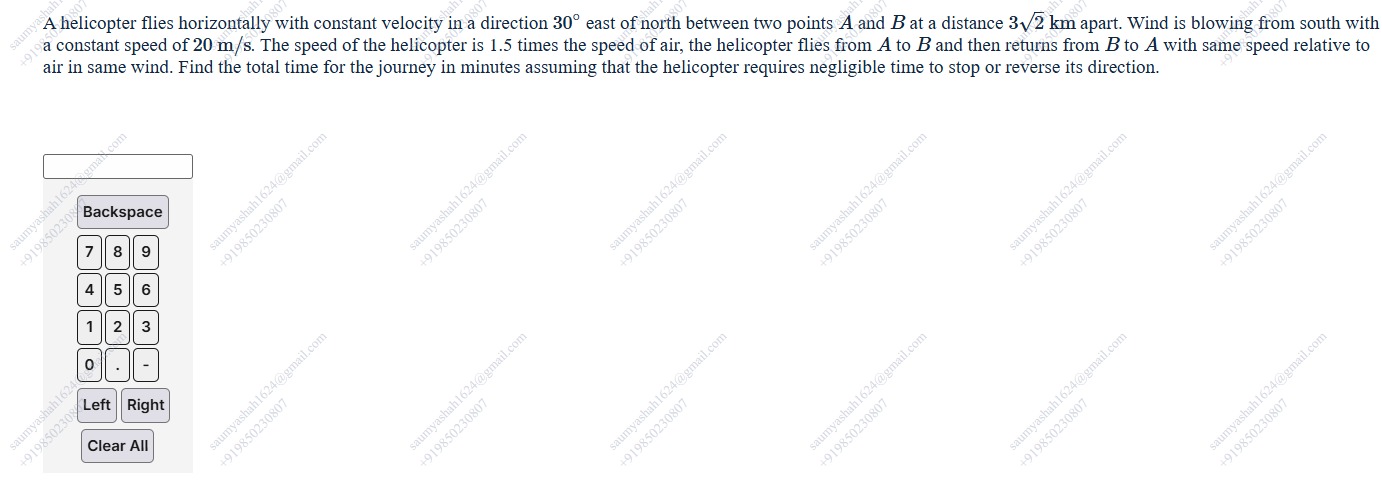Question
Question: A helicopter flies horizontally with constant velocity in a direction $30^\circ$ east of north betwe...
A helicopter flies horizontally with constant velocity in a direction 30∘ east of north between two points A and B at a distance 32 km apart. Wind is blowing from south with a constant speed of 20 m/s. The speed of the helicopter is 1.5 times the speed of air, the helicopter flies from A to B and then returns from B to A with same speed relative to air in same wind. Find the total time for the journey in minutes assuming that the helicopter requires negligible time to stop or reverse its direction.

8
Solution
The helicopter flies from point A to point B and then returns from B to A. The distance between A and B is d=32 km. The direction from A to B is 30∘ east of north. Let's set up a coordinate system with the positive x-axis pointing east and the positive y-axis pointing north. The direction from A to B is represented by a unit vector u^AB=sin(30∘)i^+cos(30∘)j^=21i^+23j^. The direction from B to A is u^BA=−u^AB=−21i^−23j^. The distance d=32 km =32×1000 m.
The wind is blowing from the south with a constant speed of vw=20 m/s. This means the wind velocity is directed towards the north, so vw=20j^ m/s. The speed of the helicopter relative to the air is vh=1.5×vw=1.5×20=30 m/s.
Let v be the velocity of the helicopter relative to the ground. The relationship between the velocities is v=vh+vw.
Journey from A to B: The helicopter flies with a constant velocity vAB relative to the ground in the direction u^AB. Let the magnitude of this velocity be vAB. So, vAB=vABu^AB=vAB(21i^+23j^). Let the velocity of the helicopter relative to the air be vh,AB with magnitude vh=30 m/s. Let vh,AB=vh(cosθi^+sinθj^). vAB=vh,AB+vw vAB(21i^+23j^)=30cosθi^+30sinθj^+20j^ vAB(21i^+23j^)=30cosθi^+(30sinθ+20)j^ Comparing components: 2vAB=30cosθ⟹cosθ=60vAB 2vAB3=30sinθ+20⟹sinθ=60vAB3−40 Using cos2θ+sin2θ=1: (60vAB)2+(60vAB3−40)2=1 vAB2+(vAB3−40)2=3600 vAB2+3vAB2−803vAB+1600=3600 4vAB2−803vAB−2000=0 vAB2−203vAB−500=0 Solving the quadratic equation for vAB: vAB=2203±(−203)2−4(1)(−500)=2203±1200+2000=2203±402=103±202. Since vAB>0, we take the positive root: vAB=103+202 m/s. Time taken for A to B: tAB=vABd=103+20230002=3+223002=(3)2−(22)23002(3−22)=3−8300(6−4)=−5300(6−4)=60(4−6) seconds.
Journey from B to A: The helicopter flies with a constant velocity vBA relative to the ground in the direction u^BA. Let the magnitude of this velocity be vBA. So, vBA=vBAu^BA=vBA(−21i^−23j^). Let the velocity of the helicopter relative to the air be vh,BA with magnitude vh=30 m/s. Let vh,BA=30(cosϕi^+sinϕj^). vBA=vh,BA+vw vBA(−21i^−23j^)=30cosϕi^+30sinϕj^+20j^ −vBA(21i^+23j^)=30cosϕi^+(30sinϕ+20)j^ Comparing components: −2vBA=30cosϕ⟹cosϕ=−60vBA −2vBA3=30sinϕ+20⟹sinϕ=60−vBA3−40 Using cos2ϕ+sin2ϕ=1: (−60vBA)2+(60−vBA3−40)2=1 vBA2+(vBA3+40)2=3600 vBA2+3vBA2+803vBA+1600=3600 4vBA2+803vBA−2000=0 vBA2+203vBA−500=0 Solving the quadratic equation for vBA: vBA=2−203±(203)2−4(1)(−500)=2−203±1200+2000=2−203±402=−103±202. Since vBA>0, we take the positive root: vBA=−103+202=202−103 m/s. Time taken for B to A: tBA=vBAd=202−10330002=22−33002=(22)2−(3)23002(22+3)=8−3300(4+6)=5300(4+6)=60(4+6) seconds.
Total time for the journey T=tAB+tBA=(240−606)+(240+606)=480 seconds. The question asks for the total time in minutes. T=480 seconds=60480 minutes=8 minutes.
